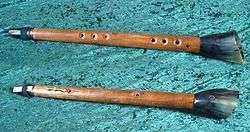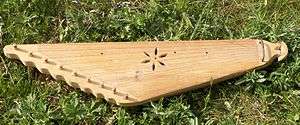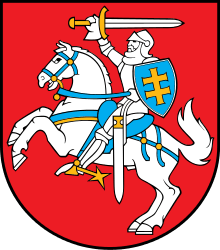Music of Lithuania
| Part of a series on the |
| Culture of Lithuania |
|---|
 |
| History |
| People |
| Languages |
|
Mythology and folklore |
| Cuisine |
| Festivals |
| Religion |
| Art |
| Literature |
|
Music and performing arts |
| Sport |
|
Monuments |
|
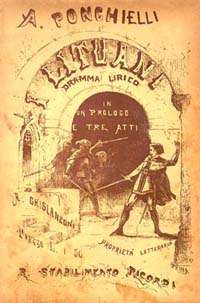
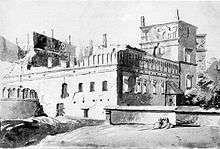
Music of Lithuania refers to all forms of music associated with Lithuania, which has a long history of the folk, popular and classical musical development. Music was an important part of polytheistic, pre-Christian Lithuania - rituals were accompanied by music instruments and singing, deeds of the heroes and those who didn't return from the war were celebrated in songs.
History
First professional music was introduced to Lithuania with travelling monks in XIth century. After the christianization of Lithuania in 1387, religious music started to spread, Gregorian chant was introduced. Travelling musicians arranged concerts in the manors and castles of the Lithuanian nobleman, local cappellas were founded.
It is known, that Anna, Grand Duchess of Lithuania, wife of Vytautas the Great which had diplomatic relationships with the Teutonic Knights, who sent her expensive gifts, including clavichord and portative organ in 1408.[1] Daughter of Grand Duke of Lithuania Gediminas, Aldona, when married to Casimir III of Poland, 1325 took her palace orchestra to Cracow.[2] It had musicians which played lute, zither and lyre.
The first opera in Lithuania was staged in the Palace of the Grand Dukes of Lithuania in 1636. Marco Scacchi and Virgilio Puccitelli were the opera's impresarios. The appearance of the opera in Lithuania is quite early, especially considering the fact that italian opera phenomena was formed at about 1600 and first opera staged in Paris was just before 1650.
In 17th century in Palace of the Grand Dukes of Lithuania 3 Italian operas were staged - all by palace composer Marco Scacchi, to librettos by Virgilio Puccitelli - Il ratto d’Elena (The Elena Kidnapping) (1636), L'Andromeda (Andromeda) (1644), Circe Delusa (Disillusioned Circe) (1648). The cultural life of the Palace of the Grand Dukes of Lithuania was especially intense during the reign of Sigismund II Augustus. The Vilnius residence was a place to host many chamber concerts, music and dance festivities and carnivals, and music has become an integral part of the public life of the Palace. Musicians from other countries, especially from Italy, were invited to Vilnius. Among the most notable was Hungarian composer and lutenist Bálint Bakfark, who came to Vilnius from Rome.[3] Composer and lutenist Michelagnolo Galilei, brother of Galileo Galilei was playing in the court of Radvila in Vilnius in 17th century. Approximately 100 musicians worked in Vilnius at the court of Mikalojus Radvila Juodasis, the Protestant Grand Chancellor of the Grand Duchy of Lithuania and the Palatine of Vilnius (1515–1565).[4]
First printed Lithuanian book Catechismusa Prasty Szadei (The Simple Words of Catechism) in 1547 contained 11 religious hymns in Lithuanian with sheet music. Lithuanian jesuit Žygimantas Liauksminas (Sigismundus Lauxmin) published the first music handbook in Lithuania - Ars et praxis musica in 1667. It was a first book of the trilogy, devoted to Gregorian chant - other books include Graduale pro exercitatione studentium and Antifonale ad psalmos, iuxta ritum S. Romanae Ecclesiae, decantandos, necessarium. The books were published at the University of Vilnius - S.R.M. Academicis Societatis Jesu.[5]
Recent findings - The Sapieha Album (Sapiegos albumas) and the Diary of the Kražiai Organist (Kražių vargoninko dienoraštis) demonstrated that the big part of the Lithuanian church music of XVII century was directly influenced by the most prominent composers of Italy of that time - Girolamo Frescobaldi; Italian organ tablature notation prevailed, basso continuo was studied.[5]
One of the first professional Lithuanian musicians was Juozas Kalvaitis (1842-1900). He composed a four-voiced Mass in the Lithuanian language in Tilžė.[6] First national opera Birutė by composer Mikas Petrauskas (1873-1937), libretto - Gabrielius Landsbergis-Žemkalnis (1852-1916) was staged in 1906.
Folk music
Lithuanian folk music belongs to Baltic music branch which is connected with neolithic corded ware culture. In Lithuanian territory meets two musical cultures: stringed (kanklių) and wind instrument cultures. These instrumental cultures probably formed vocal traditions. Lithuanian folk music is archaic, mostly used for ritual purposes, containing elements of paganism faith.
Vocal music
There are three ancient styles of singing in Lithuania connected with ethnographical regions: monophony, multi-voiced homophony, heterophony and polyphony. Monophony mostly occurs in southern (Dzūkija), southwest (Suvalkija) and eastern (Aukštaitija) parts of Lithuania. Multi-voiced homophony, widespread in entire Lithuania, is the most archaic in Samogitia. Traditional vocal music is held in high esteem on a world scale: Lithuanian song fests and sutartinės multipart songs are on the UNESCO's representative list of the Masterpieces of the Oral and Intangible Heritage of Humanity.
Sutartinės (multipart songs)
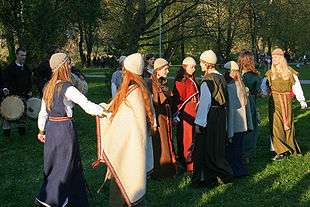
Sutartinės (from the word sutarti—to be in concordance, in agreement, singular sutartinė) are highly unique examples of folk music. They are an ancient form of two and three voiced polyphony, based on the oldest principles of multivoiced vocal music: heterophony, parallelism, canon and free imitation. Most of the sutartinės' repertoire was recorded in the 19th and 20th centuries, but sources from the 16th century on show that they were significant along with monophonic songs. At present the sutartinės have almost become extinct as a genre among the population, but they are fostered by many Lithuanian folklore ensembles.
The topics and functions of sutartinės encompass all major Lithuanian folk song genres. Melodies of sutartinės are not complex, containing two to five pitches. The melodies are symmetrical, consisting of two equal-length parts; rhythms are typically syncopated, and the distinctly articulated refrains give them a driving quality.
Sutartinės can be classed into three groups according to performance practices and function:
- Dvejinės (“twosomes”) are sung by two singers or two groups of singers.
- Trejinės (“threesomes”) are performed by three singers in strict canon.
- Keturinės (“foursomes") are sung by two pairs of singers.
Sutartinės are a localized phenomenon, found in the northwestern part of Lithuania. They were sung by women, but men performed instrumental versions on the kanklės (psaltery), on horns, and on the skudučiai (pan-pipes). The rich and thematically varied poetry of the sutartinės attests to their importance in the social fabric. Sutartinės were sung at festivals, gatherings, weddings, and while performing various chores. The poetic language while not being complex is very visual, expressive and sonorous. The rhythms are clear and accented. Dance sutartinės are humorous and spirited, despite the fact that the movements of the dance are quite reserved and slow. One of the most important characteristics of the sutartinės is the wide variety of vocables used in the refrains (sodauto, lylio, ratilio, tonarilio, dauno, kadujo, čiūto, etc.).
Wedding songs
Different vocal and instrumental forms developed, such as lyrical, satirical, drinking and banqueting songs, musical dialogues, wedding laments, games, dances and marches. From an artistic standpoint the lyric songs are the most interesting. They reflect the entirety of the bride's life: her touching farewells to loved ones as she departs for the wedding ceremony or her husband's home, premonitions about the future, age-old questions about relationships between the mother-in-law and daughter-in-law, and the innermost thoughts and emotions of the would-be bride.
War-historical time songs
Chronicles and historical documents of the 13th through 16th centuries contain the first sources about songs relating the heroics of those fallen in battle against the Teutonic Knights. Later songs mention the Swedes, there are frequent references to Riga and Battle of Kircholm; songs collected in the early 19th century mention battles with the Tatars. Songs from uprisings and revolutions, as well as anti-Soviet guerrilla resistance in 1945-1952 and deportation songs are also classified as wartime historical songs.
Calendar cycle and ritual songs
They were sung at prescribed times of the year while performing the appropriate rituals. There are songs of Shrovetide and Lent, Easter swinging songs, and Easter songs called lalavimai. The Advent songs reflect the mood of staidness and reflection. Christmas songs contain vocables such as kalėda, lėliu kalėda; oi kalėda kalėdzieka, while Advent songs contain vocables such as leliumoj, aleliuma, aleliuma rūta, aleliuma loda and others. There are several typical melodic characteristics associated with Christmas ritual songs, such as a narrow range, three-measure phrases, dance rhythms, a controlled slow tempo, and a tonal structure based on phrygian, mixolydian or aeolian tetrachords. Polyphonic St. John's Feast songs are commonly called kupolinės, which include refrains and vocables such as kupolėle kupolio, kupolio kupolėlio, or kupole rože.
Work songs
Work songs vary greatly in function and age. There are some very old examples, which have retained their direct relation with the rhythm and process of the work to be done. Later work songs sing more of a person's feelings, experiences and aspirations. The older work songs more accurately relate the various stages of the work to be done. They are categorized according to their purpose on the farm, in the home, and so on.
- Herding songs. Shepherd songs are sung by children, while nightherding songs are sung by adults. The shepherding songs reflect the actual tending of animals, the social situation of children, as well as references to ancient beliefs. The raliavimai or warbles are also recitative type melodies, distinguished by the vocable ralio, which is meant to calm the animals. The raliavimai have no set poetic or musical form being free recitatives, unified by the refrains. Some warbles end in a prolonged ululation, based on a major or minor third.
- Haymaking songs. Refrains are common in haymaking songs. The most common vocable used is valio, hence — valiavimas, the term for the singing of haymaking songs. The vocable is sung slowly and broadly, evoking the spacious fields and the mood of the haymaking season. The melodies of earlier origin are similar to other early work songs while more modern haymaking songs have a wider modal range and are structurally more complex. Most are in major and are homophonic.
- Rye harvesting songs. The harvesting of rye is the central stage in the agricultural cycle. The mood is doleful and sad, love and marriage are the prevailing topics in them. Family relationships between parents and children are often discussed, with special emphasis on the hard lot of the daughter-in law in a patriarchal family. Rye harvesting songs have rhythmic and tonal structures in common, which attests to their antiquity. Their unique melodic style is determined by close connection to ritual and the function of the work. The modal-tonal structure of some of these songs revolves around a minor third, while others are built on a major tetrachord.
- Oat harvesting, flax and buckwheat pulling and hemp gathering songs. Oat harvesting songs sing of the lad and the maid, of love and marriage as well as the work process: sowing, harrowing, cultivating, reaping, binding, stacking, transporting, threshing, milling, and even eating. In addition to the monophonic oat harvesting songs of Dzūkija, there are quite a few sutartinės from northern Aukštaitija, which are directly related to the job of growing oats.
- Milling songs. The genre can be identified by characteristic refrains and vocables, such as zizui malui, or malu malu. They suggest the hum of the millstones as well as the rhythm of the milling. Milling was done by women, and the lyrics are about women's life and family relationships, as well as the work itself. Milling songs are slow tempo, composed, the melodic rhythm varies little.
- Spinning and weaving songs. In spinning songs the main topic is the spinning itself, the spinner, and the spinning wheel while weaving songs mention the weaving process, the weaver, the loom, the delicate linens. Some spinning songs are cheerful and humorous, while others resemble the milling songs which bemoan the woman's hard lot and longing for their homes and parents. The texts describe the work process, while the refrains mimic the whirring of the spinning wheel. There are also highly unique spinning sutartinės, typified by clear and strict rhythms.
- Laundering songs. Sometimes the refrain imitates the sounds of the beetle and mangle — the laundering tools. The songs often hyperbolyze images of the mother-in-law's outlandish demands, such as using the sea instead of a beetle, and the sky in place of a mangle, and the treetops for drying.
- Fishing and hunting songs. Fishing songs are about the sea, the bay, the fisherman, his boat, the net, and they often mention seaside place names, such as Klaipėda or Rusnė. The emotions of young people in love are often portrayed in ways that are unique only to fishing songs. The monophonic melodies are typical of singing traditions of the seaside regions of Lithuania. Hunting motifs are very clearly expressed in hunting songs.
- Berry picking and mushroom gathering songs. These are singular songs. Berry picking songs describe young girls picking berries, meeting boys and their conversations. Mushroom gathering songs can be humorous, making light of the process of gathering and cooking the mushrooms, describing the "war" of the mushrooms or their "weddings."
Instrumental music
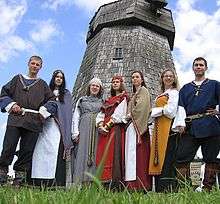
The rateliai (round dances) have long been a very important part of Lithuanian folk culture, traditionally performed without instrumental accompaniment. Since the 19th century, however, fiddle, basetle, lamzdeliai and kanklės came to accompany the dances, while modern groups also incorporate bandoneon, accordion, concertina, mandolin, clarinet, cornet, guitar and harmonica. During the Soviet era, dance ensembles used box kanklės and a modified clarinet called the birbynės; although the Soviet ensembles were ostensibly folk-based, they were modernized and sanitized and used harmonized and denatured forms of traditional styles.[7]
The most important Lithuanian popular folk music ensembles included Skriaudžių kanklės, formed in 1906, and Lietuva. Such ensembles were based on traditional music, but were modernized to be palatable to the masses; the early 20th century also saw the spread of traditional musical plays like The Kupiškėnai Wedding.[7]
Some of the most prominent modern village ensembles: Marcinkonys (Varėna dst.), Žiūrai (Varėna dst.), Kalviai-Lieponys (Trakai dst.), Luokė (Telšiai dst.), Linkava (Linkuva, Pakruojis dst.), Šeduviai (Šeduva, Radviliškis dst.), Užušiliai (Biržai dst.), Lazdiniai-Adutiškis (Švenčionys dst.). Some of the most prominent town folklore groups: Ratilio, Ūla, Jievaras, Poringė (Vilnius), Kupolė (Kaunas), Verpeta (Kaišiadorys), Mėguva (Palanga), Insula (Telšiai), Gastauta (Rokiškis), Kupkiemis (Kupiškis), Levindra (Utena), Sūduviai (Vilkaviškis). Children folk groups: Čiučiuruks (Telšiai), Kukutis (Molėtai), Čirulis (Rokiškis), Antazavė (Zarasai dst.).
Classical music
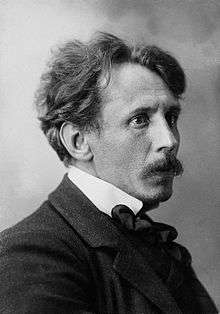
Mikalojus Konstantinas Čiurlionis (September 22 [O.S. September 10] 1875 in Varėna—April 10 [O.S. March 28] 1911 in Pustelnik near Warsaw) was a Lithuanian painter and composer. During his short life he created about 200 pieces of music. His works have had profound influence on modern Lithuanian culture.
Čiurlionis studied piano and composition at the Warsaw Conservatory (1894–1899). Later he attended composition lectures at the Leipzig Conservatory (1901–1902). His symphonic poems In the Forest (Miške) and The Sea (Jūra) were performed only posthumously.
The Čiurlionis String Quartet performs in Lithuania and abroad. Every several years junior performers from Lithuania and neighbouring countries take part in The Čiurlionis Competition.

Modern classical composers emerged in seventies - Bronius Kutavičius, Feliksas Bajoras, Osvaldas Balakauskas, Onutė Narbutaitė, Vidmantas Bartulis and others. Most of those composers explored archaic Lithuanian music and its harmonic combination with modern minimalism and neoromanticism.[8]
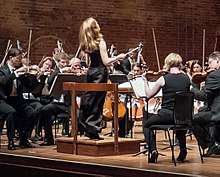
Osvaldas Balakauskas (born 1937, Miliūnai) Graduated from the Vilnius Pedagogical Institute in 1961, attended Boris Lyatoshinsky's composition class at Kiev Conservatory in 1969. From 1992 to 1994 Balakauskas was ambassador of Lithuania and in 1996 he was awarded with the Lithuanian National Award, the highest artistic and cultural distinction in Lithuania. He is currently head of the Composition Department of the Lithuanian Academy of Music and Theatre. His output consists of symphonies, concertos, chamber and instrumental music.
Conductor and music director of City of Birmingham Symphony Orchestra, Mirga Gražinytė-Tyla is known for her flamboyance and steely poise.[9] She is also in top 5 of woman conductors.[10]
In 1996 Music Information Centre Lithuania (MICL) was founded. It collects, promotes and shares information on Lithuanian musical culture.
- Bronius Kutavičius
- Juozas Gruodis
- Stasys Vainiūnas
- Kazimieras Viktoras Banaitis
- Vidmantas Bartulis
- Feliksas Bajoras
- Jonas Nabažas
- Vytautas Barkauskas
- Julius Juzeliūnas
- Eduardas Balsys
- Jeronimas Kačinskas
- Giedrius Kuprevičius
- Vytautas Bacevičius
- Šarūnas Nakas
- New Ideas Chamber Orchestra NICO
- lt:Justė Janulytė
- Vytautas V. Jurgutis
- Ričardas Kabelis
- Dominykas Digimas
- Rytis Mažulis
- Faustas Latėnas
- Algirdas Klova
- Giedrius Puskunigis
Opera
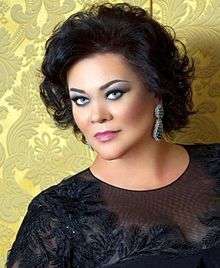

Choral music
In Lithuania choral music is very important. Only in Vilnius city there are three choirs laureates at the European Grand Prix for Choral Singing. Vytautas Miškinis (born 1954) is a composer and choir director who is very popular in Lithuania and abroad. He has written over 400 secular and about 150 religious works.
Rock music

The Communist government of the Lithuanian SSR criticized rock music, which was considered a decadent and corrupting cultural invasion from the West. The first local rock bands started to emerge around 1965 and included Kertukai, Aitvarai and Nuogi ant slenksčio in Kaunas, and Kęstutis Antanėlis, Vienuoliai, and Gėlių Vaikai in Vilnius, among others.
Radio Luxembourg was the most important source of information about the music on other side of the Iron Curtain. It was very common for Lithuanian hippies or band players to listen to this radio. Radio Luxemburg bears strong associations in Lithuania with the R.Kalanta generation (Kalantos karta). Another means was to smuggle LPs of popular Western bands into Lithuania and copy them onto magnetic tape. The records then spread further by making recordings to the friends, classmates.
Unable to express their opinions directly, the Lithuanian artists began organizing patriotic Roko Maršai and were using metaphors in their songs lyrics, which were easily identified for their true meanings by the locals.[11][12] Postmodernist rock band Antis and its vocalist Algirdas Kaušpėdas were one of the most active performers who mocked the Soviet regime by using metaphors. For example, in the song Zombiai (Zombies), the band indirectly sang about the Red Army soldiers who occupied the state and its military base in Ukmergė.[13][14] Vytautas Kernagis' song Kolorado vabalai (Colorado beetles) was also a favorite due to its lyrics in which true meaning of the Colorado beetles was intended to be the Soviets decorated with the Ribbons of Saint George.[15]
In the early independence years, rock band Foje was particularly popular and gathered tens of thousands of spectators to the concerts.[16] After disbanding in 1997, Foje vocalist Andrius Mamontovas remained one of the most prominent Lithuanian performers and an active participant in various charity events.[17] Marijonas Mikutavičius is famous for creating unofficial Lithuania sport anthem Trys milijonai (Three million) and official anthem of the EuroBasket 2011 Nebetyli sirgaliai (English version was named Celebrate Basketball).[18][19]
In the 1980s, rock bands Foje, Antis, and Bix made a big impact in Lithuania. In 1987, 1988 and 1989 Lithuania saw several big rock festivals, such as Roko Maršas (Rock March). Roko Maršas was connected to the ideology of Sąjūdis.
- Saulės laikrodis
- Žalvarinis
- Antis
- Colours of Bubbles
- ba
- Garbanotas Bosistas
- Bix
- Skylė
- Rebelheart
- Poliarizuoti stiklai
- Hiperbolė
- Kontrabanda
- Atalyja
Punk rock
1986-1987 marked the appearance of the punk-scene in Lithuania. Bands like Už Tėvynę (For the Fatherland), Genocidas Raudonajam Interventui (A Genocide for The Red Intervents), SKAT, and Erkė maiše were citing old fashioned punk 77, while others like 33% kiaulių pakeliui į Vatikaną and Turboreanimacija were more inclined towards hardcore punk (HC) stylistics. Turboreanimacija can undoubtedly be regarded as the most influential HC band of Lithuania, which in its time was well received by such fanzines as Maximumrocknroll in the US. Their first up-tempo albums reminded listeners of early records from Scottish HC legends The Exploited, while later Turboreanimacija embarked on the power-punk road. Turboreanimacija was disbanded in 1997 after granting themselves status of a cult-band among the Lithuanian underground.
More recent acts of this genre are ska-punk band Dr.Green (who are famous for their numerous DIY activities and intensive touring through the punk scenes of Europe), street-punkers Toro Bravo and hardcorists Bora and Mountainside.
Pop music

Origins of Lithuanian pop music are in music of the cafes and restaurants of temporary capital of Lithuania - Kaunas in 1930s. It was called estradinė muzika (estrade-music), lengvoji muzika (light music) and the phenomena sometimes named as mažoji scena (the little stage). Pop music bands Kopų balsai (Sounds of the dunes) [20] (in the beginning influenced by Juozas Tiškus orchestra), created in 1957 and band Nerija, which started activity in 1970 became very popular in Lithuania.
From 2000s on, the most popular band in Lithuania is SKAMP. Happyendless, Freaks on Floor, Ten Walls, Jurga and Leon Somov & Jazzu became internationally popular and put Lithuania spot on the map for quality music. Although some pop groups sing in English, pop music in Lithuanian language is very popular.
- Vytautas Kernagis
- Daddy Was A Milkman
- lt:Moniqué
- Sel
- lt:Beatrich
- GJan
- Marijonas Mikutavičius
- Žas
- Keymono
- Monika Linkytė
- Donny Montell
- Naktinės Personos
- LT United
Heavy metal
- Katedra
- Rojaus tūzai
- Au-Dessus
- Ekstravanganza
- Obtest
- lt:Dissimulation
- Luctus
- lt:Thundertale
Hip hop
- Lilas ir Innomine
- G&G Sindikatas
- Flying Saucer Gang
Electronic / Experimental / DJ
The group Saulės laikrodis created in 1976, Argo - in 1979, and D.A.17 created in 1986, considered the pioneers of electronic music in Lithuania. Classical composer Teisutis Makačinas issued his album Disko muzika (Disko music) in 1982 playfully using Moog synthesizer. Sound director of Argo, Orūnas Urbonas constructed sound synthesizers (quasi-moog) for the group needs.[21] In 2002-2010 Pieno lazeriai (Milky lasers), produced by De-Phazz leader Pit Baumgartner, played in nu jazz style. Since 2004 RyRalio Djs became famous for quality house music.
- Argo
- Sheep Got Waxed
- Ir Visa Tai Kas Yra Gražu Yra Gražu
- lt:Vilkduja
- Arturas Bumsteinas
- Sraigės Efektas
- lt:Bjelle ir PERU
- Kamanių šilelis
- lt:Pieno lazeriai
- Golden Parazyth
- Solo Ansamblis
- Without Letters
- D.A.17
- EXEM
- Manfredas
- Gediminas Žygus
- OBŠRR
- Fingalick
- Gardens of God
- Partyzanai
- Spanxti
- Girių dvasios
- RyRalio
- Ten Walls
- Dynoro
- Junior A
- Beissoul & Einius
Jazz music
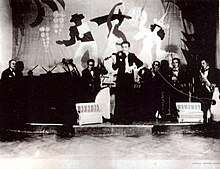
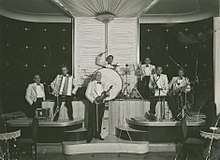
Jazz was quite often mentioned in the press of Lithuania before the WWII. Back in Lithuania's first period of independence (1918-1940), the country was part of swinging Europe. Nearly every Lithuanian town had its own jazz band, and traditional jazz repertoire was performed by prestigious orchestras under the leadership of Mykolas Hofmekleris (violinist),[22][23][24] Abraomas Stupelis (violinist), Danielius Pomerancas (violinist).[25] Jazz was played in the modern cafés and restaurants of interbellum Kaunas - Konradas, Monika, Aldona, Versalis, Metropolis. In 1935 in the cinema Metropolitain, first concert of jazz orchestra took place. The jazz orchestra was assembled from leading musicians of Kaunas, most likely the basis was a band which played in the Konradas café in the Laisvės Alley.[26] In 1940 in Kaunas Radio (Kauno radiofonas) was the first official jazz orchestra launched and led by Abraomas Stupelis. He is considered the pioneer of the Lithuanian big band.[27][28] Mykolas Hofmekleris in 1932 was decorated with the Order of the Lithuanian Grand Duke Gediminas for his activity in the field of music.[29]
Soviet occupation destroyed much of the vibrant cultural life, cafes were closed, jazz was considered as an ideologically and politically charged music of the West. Jazz scene was active even during the years of Soviet occupation. First sign of revival was an orchestra of Kaunas Polytechnic Institute led by Juozas Tiškus. Juozas Tiškus formed a professional swing orchestra of 28 members. Juozas Tiškus is also considered one of the instigators of popular Lithuanian music. The real breakthrough would occur in 1970-71 with the coming together of the Ganelin/Tarasov/Chekasin trio, the alleged instigators of the Vilnius Jazz School.[30] The trio, known also as Ganelin Trio or GTCh combined free jazz with elements of Lithuanian folk and classic music. Café Neringa in Vilnius and café Tulpė (former Konradas) in Kaunas became places for jazz lovers and players.
Almost anything can be found on the jazz scene in Lithuania today, from Dixieland and a cappella groups, to all kinds of jazz fusion, nu-jazz and jazzcore.[31]
There are quite a few international jazz festivals in Lithuania:
- Vilnius Jazz Festival
- Vilnius Mama Jazz
- Birštonas Jazz
- Kaunas Jazz
- Klaipėda Castle Jazz Festival
- Nida Jazz
and some other.
Jazz bands and performers:
- Vytautas Labutis
- lt:Petras Vyšniauskas
- lt:Saulės kliošas
- Juozas Milašius
- lt:Liudas Mockūnas
- Dainius Pulauskas
- Magic Mushrooms
- Lithuanian Radio and Television Big Band
- Kęstutis Vaiginis
- Darius Rudis
- Dalius Naujokaitis
- Tomas Kutavičius
- Kęstutis Lušas
- Rasa Serra
Music festivals and events
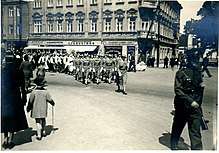
1924 saw the first Dainų šventė (The Lithuanian Song Festival), song festivals which were state-supported and helped to keep folk traditions alive; these were held every five years. The 1960s saw people rebelling against these Soviet-controlled traditions, and led a roots revival that soon led to celebrations of Lithuanian identity in festivals and celebrations.[7]
Lithuania is home to many folk music festivals. The Dainų šventė song festival is perhaps the most famous; it was first held in 1924, and has continued every five years since. Other major folk festivals include the Skamba skamba kankliai and the Atataria trimitai, both held annually; of historical importance is the Ant marių krantelio, which was held in the 1980s and was the first major festival of its kind. The Baltica International Folklore Festival is held in one of the Baltic states every year.[7]
References
- Cronshaw, Andrew (2000). "Singing Revolutions". In Broughton, Simon and Ellingham, Mark with McConnachie, James and Duane, Orla (Ed.). World Music, Vol. 1: Africa, Europe and the Middle East. London: Rough Guides. pp. 16–24. ISBN 1-85828-636-0.
Notes
- ↑ Jonynas, Ignas (1984) [1932]. "Vytauto šeimyna". Istorijos baruose (in Lithuanian). Vilnius: Mokslas. pp. 47–50. LCC 84212910.
- ↑ "muzikos instrumentai Lietuvoje". www.vle.lt. Retrieved 1 July 2018.
- ↑ "Kultūros vakaras "Muzika Valdovų rūmuose"". www.valdovurumai.lt. Retrieved 6 June 2018.
- ↑ Kuzminskyi, Ivan. "On the influence of the Catholic Ivan Kuzminskyi musical culture of Lviv and Vilnius on partes polyphony at the end of the 16th and during the 17th centuries" (PDF). žurnalai.lmta.lt. Lithuanian Academy of Music and Theatre. p. 17. Retrieved 11 July 2018.
For example, approximately 100 musicians worked in Vilnius at the court of Mikalojus Radvila Juodasis (Mikołaj “The Black” Radziwiłł), the Protestant Grand Chancellor of the Grand Duchy of Lithuania and the Palatine of Vilnius (1515–1565)
- 1 2 Jūratė Trilupaitienė. "Keli XVIII a. LDK bažnytinės muzikos bruožai" (PDF). www.valdovurumai.lt. Retrieved 7 June 2018.
- ↑ Vytas Nakas. "The music of Lithuania — a historical sketch". www.lituanus.org. Retrieved 14 June 2018.
- 1 2 3 4 Cronshaw, pgs. 22 – 23
- ↑ "The Modern Music of Lithuania: Past & Present". www.mic.lt. Retrieved 25 March 2018.
- ↑ "Conductor Mirga Gražinytė-Tyla — a combination of flamboyance and steely poise". www.ft.com. Retrieved 5 July 2018.
On the podium she is a combination of flamboyance and steely poise. In person, Mirga Gražinytė-Tyla is just the same. When I meet the music director of the City of Birmingham Symphony Orchestra, she fills the room with her dynamism, punctuating our conversation with sudden bellows of laughter and effusive hand gestures. But there’s also a cool self-possession, a sense that this petite, immaculately turned-out Lithuanian conductor would never speak without careful deliberation. At just 31, Gražinytė-Tyla has the air of a veteran.
- ↑ "Classical Music in 2017" (PDF). bachtrack.com. Retrieved 11 August 2018.
- ↑ Tilvikaitė, Patricija. "Ir lietuviškas rokas padėjo Lietuvai atkurti Nepriklausomybę". www.universitetozurnalistas.kf.vu.lt (in Lithuanian). Retrieved 23 August 2016.
- ↑ "A. Mamontovas: "Roko maršai" buvo toks įrankis, koks dabar yra internetas". Kauno diena / LRT (in Lithuanian). Retrieved 12 March 2017.
- ↑ "Ukmergės karinis miestelis". Autc.lt. Retrieved 22 January 2018.
- ↑ "Knyga "Antiška" (II dalis): iki "Anties" lietuviai nežinojo, kas yra zombis (ištrauka, video)". Lrytas.lt (in Lithuanian). Retrieved 29 July 2013.
- ↑ Bacanskas, Benas (19 December 2014). "Dainos teatras - Kolorado vabalai (1991-12-25)". YouTube. Retrieved 19 December 2014.
- ↑ "A. Mamontovas: padėsime galutinį tašką "Foje" istorijoje - LRT". LRT (in Lithuanian). Retrieved 6 October 2013.
- ↑ "A. Mamontovas: populiarumą išnaudoju geriems darbams - LRT". LRT (in Lithuanian). Retrieved 31 October 2015.
- ↑ Marijonas Mikutavičius – Trys milijonai on YouTube
- ↑ "Marijonas Mikutavičius, Mantas, Mia - Nebetyli sirgaliai". YouTube. 15 October 2014. Retrieved 15 October 2014.
- ↑ br. Arūnas Pranciškus Peškaitis OFM. ""Kopų balsai" - išlikti ne tik atmintyje". www.bernardinai.lt. Retrieved 3 July 2018.
- ↑ "Pirmosios lietuviškos elektronikos grupės "Argo" muzikantai sintezatorių susikūrė patys". www.lrt.lt. Retrieved 14 June 2018.
„O. Urbonas dirbo radijo gamykloje Kaune, todėl jam nebuvo sunku gauti įvairiausių detalių, reikalingų šiam instrumentui sukurti. Tai buvo vienbalsis sintezatorius (kvazimugas) su dviem generatoriais, juo negalėjai groti trumpesnių ar ilgesnių natų“, – pasakoja kompozitorius.
- ↑ "Moishe Hofmekler". www.mic.lt. Retrieved 5 June 2018.
- ↑ "Lietuviai Kariai Laisvajame Pasaulyje". partizanai.org. Retrieved 5 June 2018.
Smuikininkas Mykolas Hofmekleris vasario 2 d. atsiskyrė su šiuo pasauliu, sulaukęs 67 metų amžiaus. Kaip žinome, jis buvo vienas populiariausių kapelos vedėjų ir dažnai grodavo Lietuvos kariuomenei. Jis buvo apdovanotas DLK Gedimino or-denu. Prieš kiek laiko jis įgrojo Londone apie 40 lietuviškų plokštelių, nacių valdymo laikais buvo Dachau KZ stovykloje. Kilimo buvo iš Vilniaus krašto.
- ↑ "Žydų muzikai tarpukario Kaune: Leiba Hofmekleris". www.kaunomuziejus.lt. Retrieved 5 June 2018.
- ↑ "Daniel Pomeranz". www.mic.lt. Retrieved 7 June 2018.
- ↑ "Kaunas pilnas kultūros:2016. Nuo peilio iki saksofono vienas žingsnis". issuu.com. Retrieved 7 June 2018.
- ↑ "Lithuanian Jazz in Brief". www.mic.lt. Retrieved 7 June 2018.
- ↑ "Džiazo maestro pagerbs kolegos". www.bernardinai.lt. Retrieved 7 June 2018.
- ↑ "Legendiniai mažosios scenos artistai Moišė Hofmekleris, Danielius Dolskis, Danielius Pomerancas". www.semplice.lt. Retrieved 7 June 2018.
- ↑ "Jazz in Lithuania". www.vilniusjazz.lt. Retrieved 25 March 2018.
- ↑ "Lithuanian contemporary music". lithuanianculture.lt. Retrieved 14 June 2018.
External links
- Music Information Centre Lithuania – The most comprehensive Lithuanian music database.
- pakartot.lt - Playlists and discographies of Lithuanian music.
- Lithuanian Jazz in Brief
- Lietuvos džiazo federacija - publishers of the Lithuanian Jazz
- Lithuanian Metal Artists on last.fm
- electronicbeats.net - a look into Lithuania’s vibrant electronic music scene
- (In Lithuanian) kaunasretrojazz.lt - archives about Kaunas jazz musicians in occupied Lithuania.
- (In Lithuanian) Kaunas pilnas kultūros, 2016. p 16 - chronology of the Lithuanian Jazz history.
- (In Lithuanian) - Lietuvos roko pionieriai - Pioneers of the Lithuanian rock
- (in French) Audio clips: Traditional music of Lithuania. Musée d'ethnographie de Genève. Accessed November 25, 2010.
- Anthology of Lithuanian Ethnoculture (See "Folklore" Section.)
- Vilnius Hardcore – Ska Funk Rasta Punk Scene, Vilnius
- Djscene.lt – Lithuanian nightlife news, clubs, party pics, reviews, performers, music and much more.
- Margai.lt – Lithuanian folk – music, songs, instruments, dances.
- (In Lithuanian) Rockopedia.lt - Lithuanian rock encyclopedia.
- (In Lithuanian) Džiazas Lietuvoje
- (In Lithuanian) Ars et praxis - An annual periodical of scientific articles on musicology
- www.modus-radio.com - comments about history of music of Lithuania and Lithuanian composers
